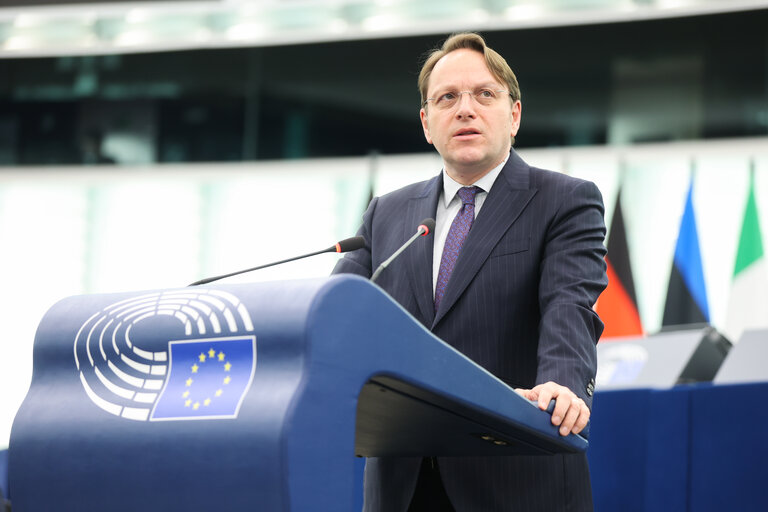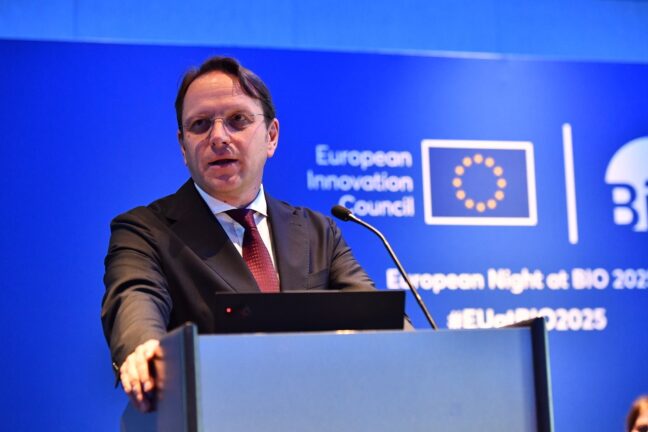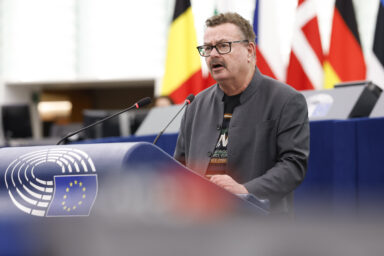As the EU prepares its Biotech Act, US stakeholders warn that without systemic reform, Europe may miss its biotech moment. Commissioner Olivér Várhelyi calls for a reimagined EU biotech and pharma ecosystem.
In response to the Commission’s call for evidence, American voices from industry, academia, and advocacy raised a clear concern. Europe excels in research, but its systems are still too slow, fragmented, and risk-averse to lead in global biotech innovation.
Their message, echoed days later by Commissioner Olivér Várhelyi at the BIO International Convention in Boston held in mid-June, is that scientific excellence alone won’t deliver results.
We want to win this competition. We have no choice but to win. We cannot afford to lose that. – Olivér Várhelyi, EU Commissioner for Health and Animal Welfare
In Europe, in his words, “…we have to do things differently in the sense that we have to make it easier to innovate in Europe. We have to make it easier to manufacture in Europe. And we have to make it much faster for therapies to get to the patients.”
Unless those systems are reformed, biotech breakthroughs may remain locked in the lab.
You might be interested
Streamlining clinical trials: a shared priority
Pfizer’s response to the Commission’s call for evidence laid out the challenge and the path forward in stark terms. “The Biotech Act should focus on optimising the clinical trials process, facilitating faster patient access to innovative therapies, ultimately improving Europe’s position as a global hub for biopharmaceutical research.”
Pfizer urged faster ethics reviews and earlier scientific dialogue. It also called for a targeted revision of the Clinical Trials Regulation (CTR) and the Clinical Trials Information System (CTIS), which industry leaders see as essential to the EU’s future competitiveness.
The Association of Clinical Research Organizations (ACRO) sounded the alarm with data. Citing figures published by European Federation of Pharmaceutical Industries and Associations (EFPIA), it said Europe’s share of global clinical trials fell from 22 per cent in 2013 to 12 per cent in 2023—translating to 60,000 fewer trial places for European patients.
Technical limitations in CTIS are “limiting clinical trial applicant capacity,” ACRO added, forcing sponsors and contract research organisations to work around system flaws with additional time and cost.
Johnson & Johnson also drew attention to the regulatory burden and fragmentation facing companies. It urged policymakers to “perform regular impact assessments, competitiveness checks, and retrospective assessments of how administrative processes impact the life science sector with a goal to reduce unnecessary red tape by at least 50 per cent by 2029, while championing a robust IP framework to provide legal certainty and encourage innovation and investment.”
Aligning fragmented rules and strengthening global links
Beyond the trials system, many U.S. contributors pointed to the bigger picture: an EU biotech landscape characterised by legal fragmentation and overregulation. The American Chamber of Commerce to the EU (AmCham EU) described the current environment as one marked by “fragmented implementation and uncoordinated regulatory layers.”
It warned that without greater coherence across regulations, from REACH to the Medical Device Regulation, the In Vitro Diagnostic Regulation and the pharmaceutical package, the EU risks losing investment and talent to regions with more predictable and navigable systems.
Biotech cannot thrive in a vacuum of policy ambition. – American Chamber of Commerce to the EU (AmCham EU)
To address this, AmCham EU urged the Commission to align its biotech policy with trusted global frameworks, such as ICH Q12 and EMA-FDA collaborations, which facilitate interoperability and reduce duplication.
“Biotech cannot thrive in a vacuum of policy ambition,” the Chamber said, underscoring that resilience must not be confused with self-sufficiency.
Global resilience and dual-use safeguards
Johnson & Johnson similarly called on the EU to “recognise the value of global and diversified networks for R&D, manufacturing and supply of medicines and medical devices, against the worrying trend of reshoring and localisation.”
The Johns Hopkins Center for Health Security focused its submission on biosecurity risks associated with emerging biotechnologies. It urged the European Commission to take a leading role in “requiring universal nucleic acid synthesis screening for providers,” while also recommending that the EU “create oversight of in silico dual-use research of concern (pertaining to AI models and generated data) to reduce risks from deliberate misuse.”
In particular, it emphasised the importance of considering pandemic-scale threats, stating that “the EU should prioritize risks of large-scale pandemic harms, both deliberate and accidenta, in the risk-benefit analyses for novel technologies.”
The Center further argued that “responsible conduct for technology development and the implementation of technical and policy safeguards that mitigate misuse potential are crucial in order to achieve downstream technology adoption, avoid setbacks through misconduct incidents, and increase public trust in science.”
Building biotech from the ground up
American stakeholders didn’t just critique, they offered solutions. Pfizer advocated for a broader investment strategy to fuel early-stage R&D and scale-up, proposing new EU-led financing initiatives based on the Innovative Health Initiative. It also called for the creation of specialised “biohubs” across the continent where research, manufacturing, and regulatory support can converge.
Startups and medium-sized enterprises (SMEs) featured prominently in the RareGen Youth Network’s response. The organisation noted that “challenges disproportionately affect small and medium-sized enterprises, spin-offs, and start-ups, the very drivers of innovation in this sector.” They identified fragmented regulatory frameworks, limited access to risk-tolerant capital, and inconsistent digital infrastructure as key barriers.
Their recommendations included accelerating regulatory alignment and market entry, scaling investment pathways, and building a cross-border biotech talent pipeline to better connect Europe’s scientific strength with commercial outcomes.
Breakthrough T1D, a global type 1 diabetes (T1D) research and advocacy organisation, called for greater regulatory coherence to support innovation in therapies that span multiple EU frameworks.
The group warned that inconsistent EU and national rules, spanning advanced therapy medicinal products, medical devices, and genetically modified organisms (GMO), “create unnecessary delays and burdens for researchers, developers, and manufacturers.”
With over 30 active clinical trials across Europe, Breakthrough T1D urged the Commission to “centralise and streamline oversight.”
The organisation also recommended creating dedicated manufacturing support infrastructure, drawing inspiration from the European Molecular Biology Laboratory (EMBL) and the Netherlands Organisation for Applied Scientific Research (TNO).
MediQuills, a U.S.-based think tank, added that recombinant vaccine development in Europe is falling behind due to disproportionate biosafety requirements and inconsistent national rules on genetically modified organisms. It urged the EU to reform its GMO framework and incentivise private-sector scale-up for next-generation vaccine technologies.
Data and talent: the biotech lifeblood
Digitally enabled biotech was another unifying theme. Pfizer called for “a clear, coherent data governance framework” that ensures the privacy of patient information while enabling researchers to harness the power of data for innovation.
Johnson & Johnson stressed the need to “champion a robust Intellectual Property framework to provide legal certainty and encourage innovation and investment.”
It also called for strong investment in skills, urging the EU to “incorporate the life science sector as a critical component in the European skills agenda, double the number of graduates in science, technology, engineering and mathematics (STEM) each year, and attract and retain an international and highly skilled workforce.”
Pfizer similarly highlighted the importance of mobility and training, pointing to Ireland’s BioPharmaChem Skillnet as a model for pan-European workforce development in regulatory science and process engineering.
A political push: Várhelyi’s biotech manifesto
Commissioner Olivér Várhelyi’s intervention at the BIO International Convention in Boston brought political momentum to the transatlantic discussion. “We have a unique opportunity ahead of us,” he told attendees, stressing that “biotechnology is going to be a key pillar” for delivering faster, more innovative therapies.
“But for this to happen, we need to do things differently,” Várhelyi said. “We have to make it easier to innovate in Europe. We have to make it easier to manufacture in Europe. And we have to make it much faster for therapies to get to the patients.”
He acknowledged Europe’s “immense” regulatory complexity, noting that “if we want these new technologies to emerge, we have to make it easier, simpler, and much faster for them to come on the market.”
We have to make it easier to innovate in Europe. We have to make it easier to manufacture in Europe – Olivér Várhelyi, EU Commissioner for Health and Animal Welfare
To reverse the decline in clinical trials, he said, “we need the clinical trials to come back to Europe… where you do the clinical trials, most probably you will manufacture.”
A new legislative framework is necessary
Outlining his vision for the Biotech Act, Várhelyi said the EU must “create a legislative framework that opens up the possibilities of developing these new therapies.” He pointed to artificial intelligence, gene therapy, and better integration between pharmaceuticals, medical devices, and digital health as strategic priorities.

Referring to EU-U.S. cooperation, he emphasised interdependence: “We are in this together.” Várhelyi said he would explore expanding existing mutual recognition agreements between the European Medicines Agency (EMA) and the U.S. Food and Drug Administration (FDA), and highlighted the importance of “mutual recognition” of clinical trials and reducing duplication.
To build manufacturing capacity, Várhelyi said the EU had introduced a flexible state aid framework allowing Member States to prioritise biotech investments with “authorization procedures [in] 60 days max.”
If production in the EU remains unviable, “don’t forget that we’re surrounded by candidate countries” that already apply Good Manufacturing Practice (GMP) and other EU standards and can join supply chains.
Summing up the stakes, he warned: “We want to win this competition. We have no choice but to win. We cannot afford to lose that.”










